
At a time when the horror genre was thriving, KONAMI’s continued neglect of the Silent Hill series was baffling. While Resident Evil reclaimed its place as one of the greatest survival-horror franchises with its seventh entry and successful remakes, and new IPs blossomed, one of the genre’s cornerstones remained dormant. With KONAMI showing little interest in reviving its legacy franchises, it often felt like we’d never return to that fog-shrouded town. Thankfully, that wasn’t the case: last year, Bloober Team’s excellent Silent Hill 2 remake brought the series back to life.
Besides remaking older entries in the series, KONAMI’s plans regarding Silent Hill’s revival include the development of new games, and the first one of these new games to launch is Silent Hill f, a survival-horror game that sets itself apart from the rest of the series with its setting, choice of main character, and gameplay features. However, don’t let these fool you. Silent Hill f is unmistakably a Silent Hill game through and through, one that balances new features with a very familiar framework to deliver not only a great survival horror experience, but also one of the best in the series to date.
Set in a small rural Japanese town called Ebisugaoka in the 60s, Silent Hill stars Hinako Shimizu, a young schoolgirl with more than a few troubles fitting into a society that wants her silent, obedient, and complacent. After another heated argument with her parents – her father a drunkard, her mother unable to stand up for herself, Hinako storms out of her home. But right from her first step outside, it’s clear that something is terribly amiss. Fog has enveloped the town, and its inhabitants seem to have shut themselves inside their homes, giving the rural village a haunting beauty. After meeting her friend Shu, whom she calls partner, Sakuko, the daughter of the local temple keepers, and Rinko, who clearly harbors feelings for Shu, Hinako realizes her uneasiness is more than justified. A monster born out of the fog attacks the group, forcing them apart, and starting a chain of events that will force Hinako on a journey through all sorts of horrors with some unpredictable consequences.
Written by Ryukishi07, known for the Higurashi and Umineko visual novels, Silent Hill f’s story fully delivers on pretty much every front, featuring an engaging dual narrative centered on Hinako, a sort of twisted coming-of-age holding some terrible secrets based on a ritual held in a mysterious temple located in the Otheworld, the dark alternate dimension that debuted with the series back in 1999, where Hinako is guided by yet polite young man wearing a fox mask that provides ample opportunities for some haunting and very disturbing sequences, and for some twisted character development in true series fashion. Saying precisely why the story delivers so much would be going into heavy spoiler territory, but you can rest assured that there are plenty of times when it is difficult to even look at the screen due to some extremely disturbing events, which hold strong symbolic significance that, while a little on the nose, are highly effective. Some unexpected twists, which are properly foreshadowed before their reveal, also contribute to making the experience memorable
Much of the quality of the Silent Hill f story also depends on how it is narrated. Besides regular cutscenes, which use some cinematic camera cuts and Unreal Engine 5’s Lumen for greater impact, the game also embraces environmental narration via documents scattered all over Ebisugaoka and some environmental elements that do tell a story if the player is ready to listen. Representing isolation with a lone school desk inside a bigger classroom may be a little too obvious, but it adds a certain depth to the narration and the game as a whole, bridging the disconnect that is too often found in certain games between narrative and gameplay, giving meaning to elements that only look decorative at a glance. A player journal deepens immersion further, offering insights into Hinako’s perceptions of the people closest to her – including her absent sister Junko, whose departure after marriage left a lasting wound – and revealing stark differences between how Hinako sees herself and how others see her.
While the Silent Hill f story sets the new entry in the series apart from every other game that came before it, the gameplay is possibly an even bigger divergence, but mainly only regarding combat. Regarding traversal and puzzle solving, Silent Hill f is as much an entry in the series as the first two Silent Hill games are, featuring multiple locations with complex designs to explore with the aid of a map, an abundance of locked or blocked doors, plenty of puzzles to complete of varying difficulty, and resources to collect, including the ever important restorative items. The puzzles, in particular, are excellent, and at Hard puzzle difficulty, they really put the player’s skills to the test without being overly complicated, though there’s a specific puzzle-heavy sequence at the halfway point of the game that feels a little frustrating and impacts an otherwise excellent pacing, which masterfully balances story, traversal, and combat. Thankfully, powering through this sequence is rather rewarding, thanks to the events that take place right after it, which represent one of the highlights of the experience, with some haunting and disturbing sequences that are very hard to forget.
Although different types of restorative items have become the norm in survival horror games, in Silent Hill f they are some of the elements that better represent the bigger divergence the game takes from the established formula. Besides items that restore Hinako’s health, you will find items that restore her Stamina and Sanity, two values that power some of the game’s core combat mechanics. Unlike other entries in the series, Silent Hill doesn’t feature any firearms, and Hinako has to rely on the makeshift weapons she can find all around Ebisugaoka – steel pipes, kitchen knives, sledgehammers, axes, and so on. To preserve the resource management mechanics so central to a survival horror experience, every weapon in the game, with only a few noteworthy exceptions, has a limited durability that can only be partially restored using rare repair kits. As such, you will still have to pick your fights and preserve your most powerful weapons for the forced combat encounters, of which the game has quite a few.
Due to the inclusion of a Stamina gauge, Silent Hill f was likened to a soulslike game before release, but the first couple of fights against some rather disturbing doll-like enemies with some great animations show how the similarities are limited to the ability to use light and heavy attacks and a rather effective dodge maneuver, which becomes a Stamina-restoring perfect dodge when timed correctly. These simple action combat mechanics are elevated by the inclusion of a Focus mode powered by the Sanity gauge, which allows Hinako to charge a powerful Focus attack that can briefly stun enemies and slow down time when the enemy is about to launch an attack that can be countered with a Heavy Attack.
Though undoubtedly more mechanically rich than your typical survival-horror combat system, Silent Hill’s combat is never truly the focus, as all these mechanics are deeply rooted in the resource management principle at the core of a survival horror experience. Stamina, for example, depletes very quickly, and using all of it up will leave Hinako pretty much defenseless for a few seconds, which is a huge problem at hard combat difficult where enemies hit rather hard; similarly, using all Sanity not only disables Focus mode, but may also cause Hinako to receive additional damage when under psychological stress, something that happens quite often during the game. And while her stats and capabilities can be enhanced by finding empty Ema and spending Faith points at shrines and equipping the Omamori accessories for passive skills, there’s never a situation where these mechanics make the schoolgirl capable of easily taking on every enemy without suffering any consequence.
Striking a balance between more involving combat and retaining that sense of fear and helplessness is very difficult to achieve, but I feel developer NeoBards Entertainment managed to do so in the best way possible, even though it is undeniable that the execution is not always perfect, like with the dodge mechanic, which is, maybe, a little too effective for a survival horror game. The other aspect of the combat system, which sparked the most discussion pre-release, is the excessive reliance on hitstop and the supposed lack of enemy reactions to attacks. On the other hand, this is not as problematic as it looks in promotional footage. While it is true that enemies do not react to light attacks, the game provides a lot of options to stagger enemies, like heavy attacks, Focus attacks and counter attacks, the latter possible even without using Focus mode.
With so many options at Hinako’s disposal, enemy design had to take this into account, and thankfully, it does so in a consistent way. Although enemy variety isn’t big, there are enough enemies to keep things fresh for the duration of the first playthrough, ranging from the aforementioned doll-like enemies to more deformed monsters who all come with a few attack patterns and unique quirks that players need to memorize to take full advantage of the many combat mechanics the game offers. For example, there’s a hulking enemy carrying a giant knife in its right arm that blocks any attack coming from Hinako’s left, which forces correct positioning together with proper timing of offense and defense. Though few, there are also boss battles built around unique mechanics that are quite effective. As such, enemy design holds up for a single playthrough, which shouldn’t be longer than 12 hours for most players. While this definitely is on the short side, the game sports great replayability with a meaningful New Game Plus and multiple endings, so there’s still a lot to be discovered, including answers to some questions left unanswered during the first playthrough, after the credits roll for the first time.
Before its release, Silent Hill f made a few heads turn for possibly being one of the few games powered by Unreal Engine 5 that wouldn’t be impacted by some of the engine’s known issues, such as visual noise and stuttering. Regarding the first, that is indeed the case. The new entry in the series looks extremely clean, with great texture work that greatly enhances the traditional Japanese rural feel of Ebisugaoka and its surroundings, and the wise usage of volumetrics and Lumen greatly enhances the series’ typical haunting atmosphere. Though far from being the best we have seen in the past few years, character models are also detailed and generally well done, and look quite believable thanks to generally solid animation work, especially for some enemies. Audio production also dramatically enhances the experience with great usage of haunting environmental sounds, and some great music pieces, some created by the series’s longtime composer, Akira Yamaoka.
Regarding performance, however, on PC, that’s not entirely the case, although the situation is far better than in most other UE5 games. The few minutes of loading that happen the first time the game is launched suggest the game has a shader pre-compilation step, which definitely helps, as I haven’t experienced shader stuttering in my time with the game outside of a single significant late-game instance which may have been caused by something else. However, traversal stuttering and some microstuttering issues are present, mostly in the main village area. These stuttering issues are not terribly aggravating, but they are easily noticeable, and they do have an impact, minimal as they may be, on an experience meant to be immersive.
Aside from these stuttering issues, which are thankfully limited to a small number of areas, Silent Hill f seems to be optimized well. At 4K resolution with NVIDIA DLSS in Quality mode and the settings above, the game ran at an average of 116 FPS, 59 1% Low on my system (i7-13700F, RTX 4080, 32 GB RAM) in a benchmarking session held in Ebisugaoka at the start of the game, right after the first attack of one of the Fog Monsters, which are, all around, pretty decent results, considering the performance cost Lumen generally has. With the game running as expected on my system, tweaking the settings, especially the lighting setting, the rendering resolution, and the upscaler setting (TSR and FSR are available besides DLSS) should be more than enough for most users with a relatively modern machine to run the game smoothly.
With an engaging story full of haunting, disturbing sequences, a finely tuned balance of everything that makes survival horror great, and combat deeply rooted in resource management, Silent Hill f is a triumphant return for the series after its long hiatus. Its short length and minor PC performance issues may disappoint some, but no fan of the franchise, or the genre, should miss one of the best survival horror releases in years.
PC version tested. Review code provided by the publisher.
9.0
WCCFTECH RATING
Silent Hill f
With a gripping and often disturbing story, a setting unlike anything seen before in the franchise, and gameplay that blends new ideas with a familiar framework, Silent Hill f shows that the series is not only back, but stronger than ever. While performance issues and a short runtime do impact the experience, they in no way diminish what is a triumphant return for one of the most important survival horror series ever
Pros
Engaging story filled with haunting, disturbing moments and some unexpected twists
Solid cast of characters
Excellent level and puzzle design
Involving combat deeply rooted in resource management
Separate difficulty settings for combat and puzzles make for great accessibility
Cons
Although there’s plenty of replay value, the first playthrough is rather short
Some combat mechanics feel a little overtuned
Minor yet noticeable performance issues on PC
Buy for from Amazon The links above are affiliate links. As an Amazon Associate, Wccftech.com may earn from qualifying purchases.



